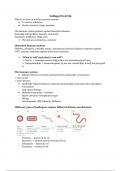College H1 & H2
Why do we have or need an immune system?
● To survive infections
● Viruses, bacteria, fungi, parasites
The immune system protects against infectious diseases;
Eenmalig:waterpokken, mazelen, rode hond
Vaccinatie: kinkhoest, ebola, pest
➢ The immune system has a memory
Disturbed immune system
Diabetes, allergieën, coeliakie, reuma, autoimmune diseases (immune responses against
‘self’), immune responses against innocuous molecules.
➢ “What is ‘self’ and what is ‘not self’?
⇒ Cancer → sommige mensen krijgen hier een immuunrespons tegen
⇒ Transplantation → immuunrespons op iets wat vreemd lijkt, terwijl het juist goed
is
The immune system
● Balance between activation and inactivation (immunity vs tolerance)
= turn on/off
= active process
● Artificially induced immune responses (kunstmatige immuunreacties opwekken)
- Vaccination
- Anti-tumor therapy
● Disturbed immunity / tolerance
- Reject (afwijzen) transplanted organ
- Allergy
- Autoimmunity (MS, Rheuma, Diabetes)
Different types of pathogens require different defense mechanisms
- Virussen → komen in de cel
- Bacteriën → kunnen buiten en binnen de cel
- Schimmels → buiten de cel
- Parasieten → buiten de cel
,Extra- and intracellular pathogens
How can the immune systems
defend the body against these
many different pathogens?
Requirement for different types of
effector cells and molecules.
● Buiten de cel → opeten, lek prikken
● Binnen de cel → cel doodmaken
- Verschillende manieren om de cel dood te maken → effector mechanismen
Diversity in immune cells
Innate immune system: fast, but not specific
Adaptive immune system: slow, but specific and memory
Cells of immune system
- Gemaakt in beenmerg
- Stamcel kan 2 afslagen nemen:
1. lymfoïde (mooi rond, grote kern, weinig cytoplasma) → B-cellen & T-cellen (adaptive
kant)
2. Myeloïde kant (hebben vesicles en worden granulocyten)
, - Polymorphonuclear granulocytes: neutrophil (meest voorkomende witte
bloedcel), eosinophil, basophil
➢ Leukocytes: white blood cells
Innate, aangeboren
Adaptive, specifiek
3 Lines of defense against invasion by pathogens:
1. Barrières → huid (= goede barrière, hele dikke laag, meeste pathogenen komen
binnen via de luchtwegen, darmen of urogenitale, zijn de weefsels met slijm, dunne
laag tussen want diffusie nodig), mucus membranes, chemicals.
2. Innate → toch binnengekomen, fagocyten, plaatselijk, snel en niet specifiek
a. er komt een bacterie binnen via wondje, dit activeert resident effector cells om
cytokines te secreten
b. warmte, pijn, roodheid, zwelling → 4 klassieke tekenen van inflammation
c. influx of cells: neutrofielen, macrofagen, fagocytose van bacteriën
d. signalering: by secretion van oplosbare eiwitten (cytokines)
e. lekken van bloed vezels: zwelling van het weefsel
, 3. Adaptive immune system → lymfocyten, antilichamen
- The surface area of mucosal tissues (slijmvliesweefsel) is huge!
- Different barriers in different tissues
First line of defense: barriers






